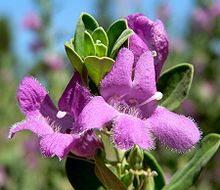| Leucophyllum | |
|---|---|

| |
| Leucophyllum frutescens 'Green Cloud' | |
| Scientific classification | |
| Kingdom: | Plantae |
| Clade: | Tracheophytes |
| Clade: | Angiosperms |
| Clade: | Eudicots |
| Clade: | Asterids |
| Order: | Lamiales |
| Family: | Scrophulariaceae |
| Tribe: | Leucophylleae |
| Genus: | Leucophyllum Humb. & Bonpl.[1] |
| Species | |
|
About 15 species, see text | |
| Synonyms | |
Leucophyllum (barometer bush or barometerbush)[2][3] is a genus of evergreen shrubs in the figwort family, Scrophulariaceae, native to the southwestern United States and Mexico. It is sometimes placed in the family Myoporaceae.[1] The dozen-odd species are often called "sages", although they have no relationship to the genus Salvia.
The solitary axillary flowers are bell- or funnel-shaped, with five lobes and two lips, and colors ranging from white to magenta to purple. The generic name is derived from the Greek words λευκός (leukos), meaning "white," and φυλλον (phyllos), meaning "leaf," referring to the trichome-covered foliage.[4]
These shrubs are found in sandy soils and have a high salt tolerance. They have become popular for edge and area plantings in warmer areas and in xeriscaping; they require minimal water, are easily shaped into hedges, and bloom over their entire surface. Cultivars of L. frutescens, L. candidum, L. laevigatum, L. langmaniae, L. pruinosum, L. revolutum, and L. zygophyllum have been developed.[5]
Leucophyllum shrubs are legendary for their ability to "forecast" rain, usually blooming several days prior to a rainstorm, apparently in response to humidity. They are sometimes called "barometer bush" for this reason. It is believed to be a survival trait in the plants' semi-desert habitats.
- ^ a b c "Genus: Leucophyllum Humb. & Bonpl". Germplasm Resources Information Network. United States Department of Agriculture. 2008-01-31. Retrieved 2011-02-17.
- ^ NRCS. "Leucophyllum". PLANTS Database. United States Department of Agriculture (USDA). Retrieved 2 June 2015.
- ^ "Lady Bird Johnson Wildflower Center at The University of Texas at Austin - Leucophyllum frutescens". www.wildflower.org. University of Texas. Retrieved 30 July 2017.
- ^ Holloway, Joel Ellis; Neill, Amanda (2005). A Dictionary of Common Wildflowers of Texas & the Southern Great Plains. TCU Press. p. 90. ISBN 978-0-87565-309-9.
- ^ "Love those Sages". Mountain States Wholesale Nursery. Archived from the original on 2010-11-25. Retrieved 2010-12-03.